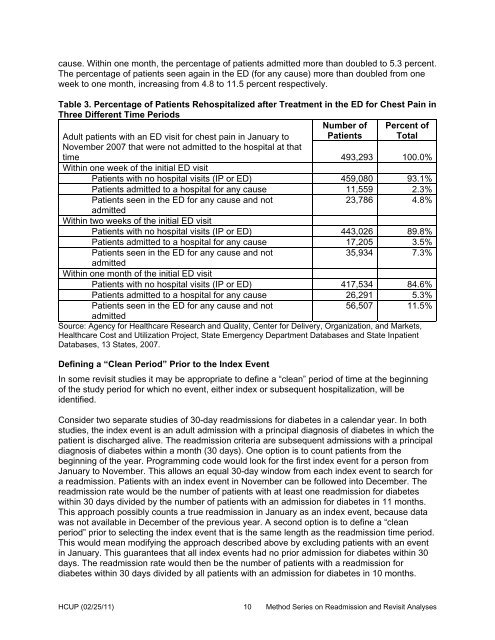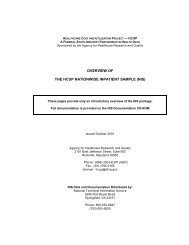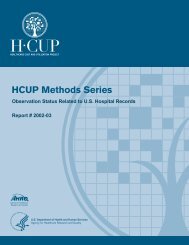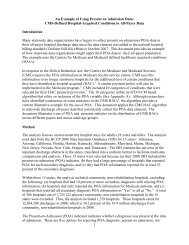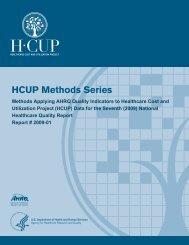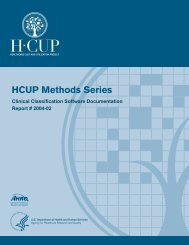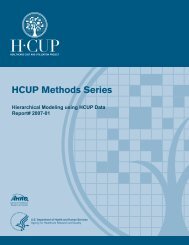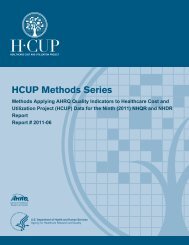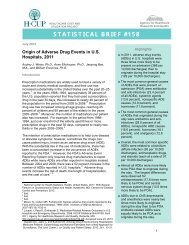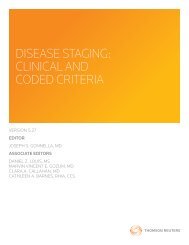Methodological Issues when Studying Readmissions and ... - HCUP
Methodological Issues when Studying Readmissions and ... - HCUP
Methodological Issues when Studying Readmissions and ... - HCUP
You also want an ePaper? Increase the reach of your titles
YUMPU automatically turns print PDFs into web optimized ePapers that Google loves.
cause. Within one month, the percentage of patients admitted more than doubled to 5.3 percent.The percentage of patients seen again in the ED (for any cause) more than doubled from oneweek to one month, increasing from 4.8 to 11.5 percent respectively.Table 3. Percentage of Patients Rehospitalized after Treatment in the ED for Chest Pain inThree Different Time PeriodsNumber of Percent ofPatients TotalAdult patients with an ED visit for chest pain in January toNovember 2007 that were not admitted to the hospital at thattime493,293 100.0%Within one week of the initial ED visitPatients with no hospital visits (IP or ED) 459,080 93.1%Patients admitted to a hospital for any cause 11,559 2.3%Patients seen in the ED for any cause <strong>and</strong> not23,786 4.8%admittedWithin two weeks of the initial ED visitPatients with no hospital visits (IP or ED) 443,026 89.8%Patients admitted to a hospital for any cause 17,205 3.5%Patients seen in the ED for any cause <strong>and</strong> not35,934 7.3%admittedWithin one month of the initial ED visitPatients with no hospital visits (IP or ED) 417,534 84.6%Patients admitted to a hospital for any cause 26,291 5.3%Patients seen in the ED for any cause <strong>and</strong> not56,507 11.5%admittedSource: Agency for Healthcare Research <strong>and</strong> Quality, Center for Delivery, Organization, <strong>and</strong> Markets,Healthcare Cost <strong>and</strong> Utilization Project, State Emergency Department Databases <strong>and</strong> State InpatientDatabases, 13 States, 2007.Defining a “Clean Period” Prior to the Index EventIn some revisit studies it may be appropriate to define a “clean” period of time at the beginningof the study period for which no event, either index or subsequent hospitalization, will beidentified.Consider two separate studies of 30-day readmissions for diabetes in a calendar year. In bothstudies, the index event is an adult admission with a principal diagnosis of diabetes in which thepatient is discharged alive. The readmission criteria are subsequent admissions with a principaldiagnosis of diabetes within a month (30 days). One option is to count patients from thebeginning of the year. Programming code would look for the first index event for a person fromJanuary to November. This allows an equal 30-day window from each index event to search fora readmission. Patients with an index event in November can be followed into December. Thereadmission rate would be the number of patients with at least one readmission for diabeteswithin 30 days divided by the number of patients with an admission for diabetes in 11 months.This approach possibly counts a true readmission in January as an index event, because datawas not available in December of the previous year. A second option is to define a “cleanperiod” prior to selecting the index event that is the same length as the readmission time period.This would mean modifying the approach described above by excluding patients with an eventin January. This guarantees that all index events had no prior admission for diabetes within 30days. The readmission rate would then be the number of patients with a readmission fordiabetes within 30 days divided by all patients with an admission for diabetes in 10 months.<strong>HCUP</strong> (02/25/11)10Method Series on Readmission <strong>and</strong> Revisit Analyses


